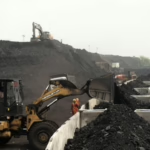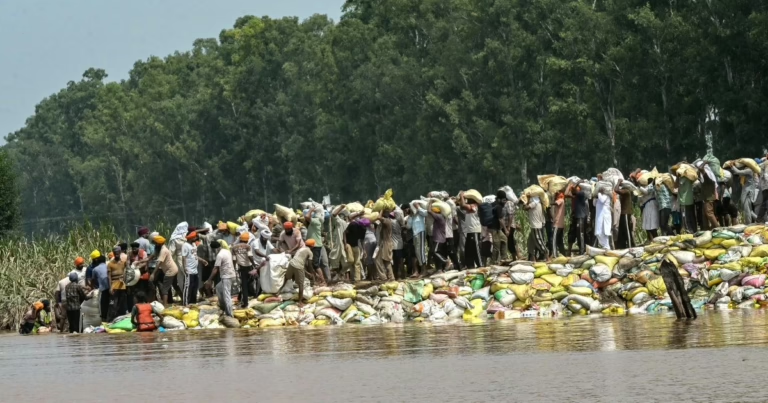Gurvinder Singh, a 47-year-old farmer from Gurdaspur in Punjab, India, found himself burdened by financial setbacks after taking a substantial loan of one million rupees ($11,000) from a private lender to fund his eldest daughter’s wedding. He invested a portion of this money into cultivating 3 acres (1.2 hectares) of paddy, choosing the high-yielding aromatic Basmati rice variety known as pearl.
Had the harvest gone well, Singh expected to earn close to one million rupees per acre ($11,400 per 0.4 hectares). Unfortunately, his hopes were dashed when floodwaters engulfed his fields, submerging the paddy under layers of mud and silt.
“This flood has come at the worst possible time for us. We are devastated,” Singh shared. “The harvest was supposed to help clear our debts, but now my fields have turned into a lake. I’m unsure how to begin again.”
Following the severe flooding earlier this month, Singh, along with his wife and two children, was forced to evacuate their home. “What awaits us when we return?” he questioned, uncertain about the future.
Enduring Consequences
The northern states of India have been battered by relentless monsoon rains, flash floods, and rising river levels, submerging entire communities and vast expanses of farmland.
Punjab, where over 35% of the population depends on agriculture, is facing an unprecedented crisis. The region is experiencing its worst flooding in four decades, with extensive paddy fields underwater just weeks before the harvest season. Rice cultivation spans nearly two-thirds of Punjab’s land area.
Gurdaspur, Singh’s home district, is among the hardest hit, situated near the overflowing Ravi, Beas, and Sutlej rivers, which swelled due to heavy rains in Jammu and Kashmir and Himachal Pradesh.
Floods have claimed at least 51 lives in Punjab and displaced approximately 400,000 residents.
Singh’s submerged paddy fields contribute to India’s $6 billion Basmati rice export industry, with Punjab responsible for 40% of the nation’s output. Across the border, Pakistan’s Punjab province, also flooded, produces 90% of Pakistan’s Basmati rice, generating nearly $900 million in revenue.
Preliminary government reports estimate that over 450,000 acres (182,100 hectares) of farmland in Punjab have been destroyed-an area roughly the size of Mauritius. However, independent agricultural economists warn that the actual damage could be up to five times greater.
“Crops are ruined, machinery is submerged, and homes have been swept away,” explained Lakhwinder Singh, director of the Centre for Development Economics and Innovation Studies at Punjabi University in Patiala.
“Farmers in Punjab face the daunting task of rebuilding from zero. Significant government aid and investment will be essential,” he added.
To date, the Punjab government, led by the Aam Aadmi Party (AAP), which opposes Prime Minister Narendra Modi’s Bharatiya Janata Party at the national level, has announced a compensation of 20,000 rupees ($230) for farmers who lost their crops. Experts argue this amount falls far short of addressing the scale of the crisis.
Approximately 6% of India’s Basmati rice exports go to the United States, which has imposed a 50% tariff on imports from India. India’s agricultural sector, employing half the country’s population-the largest in the world-has traditionally been protected, complicating trade talks with the US administration under President Donald Trump.
Singh cautioned the Indian government against exploiting the flood disaster to push for tariff reductions on food imports. “The government should not sacrifice farmers to secure trade deals with the US,” he warned. “These floods could have long-lasting effects on the agricultural economy.”

“Only Water Remains”
Punjab’s farmers now face the immediate and formidable task of clearing thick layers of mud and sediment deposited by the floods from their fields, according to agricultural experts.
Indra Shekhar Singh, an independent agricultural policy expert, emphasized that the full extent of the damage will only be clear once floodwaters recede. “Excessive silt and mud cover the fields,” he said. “Farmers will also need to level the land again, which adds to their expenses and delays preparation for the next crop.”
In India, the monsoon or “kharif” rice crop accounts for roughly 80% of total rice production and is harvested between late September and October. Now, farmers in Punjab are racing against the clock to prepare their fields for the upcoming winter wheat season, which must begin by early November to avoid yield reductions.
“Paddy fields have suffered the most damage from the floods,” Shekhar Singh noted. “Even conservative estimates point to significant losses.”
Beyond crop damage, the floods raise concerns about new diseases affecting standing crops and a looming fertilizer shortage for the Rabi season.
India’s farmers heavily depend on urea fertilizer, which contains about 46% nitrogen. The country is the world’s largest importer of urea, but stocks have sharply declined from 8.64 million tonnes in August 2024 to 3.71 million tonnes this August.
This monsoon season saw panic buying of urea across several states, and the floods have intensified fears of fertilizer scarcity for the upcoming sowing season. Globally, urea prices surged from $400 per tonne in May 2025 to $530 per tonne by September.
“This situation could trigger black market activity for fertilizers in affected states like Punjab and exacerbate the existing problem of counterfeit pesticides,” Shekhar Singh added.
Lakhwinder Singh from Punjabi University warned that farmers are facing a “prolonged economic crisis that will persist in the months ahead.”
Meanwhile, Gurvinder Singh contemplates the uncertain future for his family. Earlier this year, he married his daughter to another farmer in Amritsar, one of Punjab’s largest cities near the Pakistan border, where farmland is also submerged.
“I can’t even visit them, even though we are enduring the same hardships,” he said, reflecting on the shared struggles of communities divided by a tense border.
“We were prepared to defend these rivers fiercely,” Singh recalled, alluding to the recent hostilities between India and Pakistan after an attack in Indian-administered Kashmir killed 26 civilians. In retaliation, India suspended the Indus Waters Treaty, which governs the distribution of six rivers between the nuclear-armed neighbors-a move Pakistan labeled an “act of war.”
“Now, all that remains is water,” Singh concluded.






















